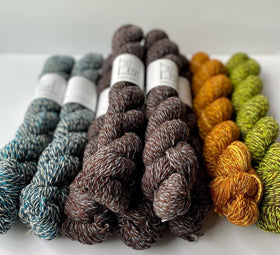
Tips for Successfully Substituting Yarns
by Meg Dedolph
I spent the first Saturday of Yarn Crawl this July behind the scenes at the shipping table, working on the store’s online orders. It gave me a front-row seat to the Plied yarn trunk show and I learned a lot listening to Ann and Beth Weaver talk to customers about their yarns.
One thing that stood out to me was listening to them talk with people who were interested in combining other yarns with Plied for various projects.
I mentioned that I’m planning a scrappy Benchmark sweater using a mix of Plied and some Jamieson’s Shetland Wool from deep stash, and Ann started telling me about how well these two yarns worked together, because they are both 100 percent wool yarns, constructed in a similar manner.
Understanding how to pick similar yarns to substitute them in a project is a big part of crocheting and knitting. Many times, you might find a project you like and discover that the yarn it was originally created with is no longer being made. Or it’s not friendly to your budget. Or it’s not friendly to your skin. Or you’d like to use a yarn from your stash instead.
While people have written entire books on how yarns are constructed and how different fibers behave - even about how different kinds of sheep’s wool behaves - there are a few basic rules we like to think about when we’re giving advice.
Pay attention to the weight of the yarn and match yarn weight as closely as you can
There are a lot of ways to describe the weight, or the thickness, of a strand of yarn. There are a lot of descriptors: laceweight is usually the thinnest, fingering is next, then sportweight, then DK (which stands for double-knitting), then worsted. Sometimes thick worsted is described as Aran-weight. Then comes bulky, and finally super-bulky.
Generally, this means that a project that was made in one brand of worsted weight yarn will work with another brand of worsted weight yarn.
The Craft Yarn Council has a numbering system that some of the bigger yarn companies use, which can also help you figure out yarn weights.
If you have a mystery ball of yarn in your stash (and who doesn’t?) with a long-gone ballband, you can determine the weight of the yarn by measuring the number of wraps per inch, abbreviated as “WPI.” There are tools to make this easier, but you can also wrap the yarn - without stretching it - around a ruler and measure the number of wraps in one inch. Then, a chart like this will give you an idea of what the yarn weight is.
Sometimes you can use two strands of a thinner yarn to get the same gauge you would with a thicker yarn, but proceed with caution, check your multiplication to make sure you have enough yarn and knit a swatch to make sure.
Actually, always swatch the yarn with the needles you plan to use. That’s the best way to make sure the yarn you want to use will work for the pattern you have in mind.
Pay attention to the fiber content of the yarn and try to match fiber content (unless you have a good reason for using a different fiber.)
Different fibers behave differently. If you have a pattern that calls for cotton yarn, it won’t look the same in wool yarn. A crocheted market bag won't stretch out of shape much with cotton yarn, but if you were to try it with a more elastic wool yarn? It might end up much bigger than you wanted.
A yarn with lots of alpaca in it might drape too much for the pattern you want to make. Some yarns look good with knitted cables, and some yarns don’t.
If you decide to use a different fiber for your project, swatching is a must. If there are cables or lace, be sure to swatch those as well just to make sure it looks and feels the way you want it to.
Pay attention to the construction of the yarn.
Yarn is made up of plies, which are strands of fiber that are twisted, or spun, into yarn. The number of plies affects how the yarn behaves and tells you something about the kind of project that it might be best suited for.
In our experience, single-ply yarns aren’t great for hard-wearing, high-friction situations. One of our popular fingering-weight yarns, Fino, is great for shawls, but I wouldn’t make socks out of it, because those go in shoes and single-ply yarns don’t stand up to that treatment the way a yarn with more plies does.

Yarns with more plies tend to appear rounder, which means they look terrific in cabled and other highly textured projects.

Swatching is your friend here. If your pattern calls for a three-ply yarn, but you want to use a two-ply yarn, such as Plied, below, see what it looks like when you knit a swatch.

(Want to add to the confusion? In some countries, “ply” is used to mean “weight.” A 4-ply yarn is a fingering weight yarn, and might only be constructed with two plies of fiber. Generally, if the number of plies is mentioned at all, it's probably being used to mean "weight" and not "how the yarn is constructed.")
Naturally, there are always exceptions. If you happen to fall in love with a DK weight yarn and you want to use it to make your favorite worsted-weight shawl, there are ways to figure out how much yarn to use and how many stitches to cast on.
With the wealth of patterns available now, there is almost always a pattern that will work with any yarn, no matter the weight, fiber content or construction.
You might notice that in all of the scenarios, a gauge swatch is important. It's true: the best way to know for sure how a yarn will work for you in any given project is to take it out for a little six-inch square test drive. A little planning up front can save a lot of grief - and ripping - in a project.




Comments
Leave a comment